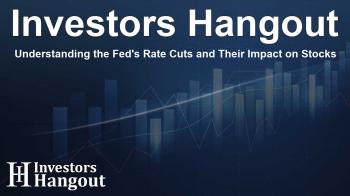Understanding the Fed's Rate Cuts and Their Impact on Stocks

Introduction to the Federal Reserve's Rate Cut Cycle
The financial landscape often shifts dramatically with decisions made by the Federal Reserve. Following a long pause since the last rate hike in 2023, the Federal Reserve embarked on its easing cycle by announcing its first rate cut. Historically, interest rates are lowered by central banks during economic slowdowns to stimulate demand and stave off recessions, which are concerning for many investors. When a recession is avoided following the rate cut cycle, it is referred to as a “soft landing.” However, if lowering rates does not boost aggregate demand, the stock market could face tough times ahead.
Historical Context of Rate-Cutting Cycles
This article examines historical rate-cutting cycles that offer valuable insights for today’s investors. Since 1984, there have been seven notable cycles initiated by rate cuts, and each one offers a unique case study of its effects on the S&P 500 index, a benchmark for equity performance.
Analyzing Past Rate-Cutting Cycles
The third rate cut in current cycles serves as an essential point of analysis. Although lower interest rates initially appear advantageous for the stock market, the eventual outcomes have varied significantly. Historically, four out of the seven reviewed easing cycles coincided with an official recession, highlighting a trend where market optimism erodes as the realization sets in that the rate cuts may not sufficiently mitigate the economic slowdown. In these instances, the market could decline sharply.
The Connection Between Rate Cuts and Market Performance
As we delve further into these cycles, it's crucial to note that while the initial cuts might yield positive reactions in stock prices, subsequent cuts can signal increasing economic distress. For instance, in the cycles studied, equity performance consistently worsened in periods leading to recessions. The maximum drawdowns for equities have been stark, particularly during downturns associated with former downturns in 2001 and 2008.
Valuation Metrics and Their Implications
One striking observation is that the periods characterized by non-recessionary outcomes were associated with more favorable valuation metrics for stocks. As of late 2024, current valuations, based on metrics like price-to-earnings and price-to-sales ratios, have already crossed previous averages, indicating a market that might be overvalued compared to its historical performance during rate cut cycles. High valuations could lead to a negative wealth effect for households, stressing the importance of analyzing market pricing relative to potential economic growth.
The Role of the Yield Curve
Another critical aspect to consider is the behavior of the Treasury yield curve. A prolonged inversion of the yield curve has previously pointed towards impending recessions. The current inversion of the 10-2 yield curve indicates a worrying trend, reminiscent of conditions leading up to past downturns. Recognizing this trend can help investors gauge the potential trajectory of the stock market.
Conclusion: Navigating Future Investments amid Uncertainty
It’s essential to approach these historical comparisons with caution. Each easing cycle has been influenced by various economic conditions, from inflation rates to other macroeconomic factors. Still, three key takeaways stand out for investors navigating this landscape:
First, the probability of adverse outcomes for equity markets increases with the duration of the rate-cutting cycle. Interestingly, markets often react negatively to reports suggesting fewer cuts than expected, contrary to logic. Secondly, maintaining lower valuations may enhance the odds of a soft landing. Lastly, anticipating yield curve shifts can offer guidance on market resilience.
In conclusion, while historical data provides a frame of reference, the evolving economic conditions require vigilant observation. Investors need to be skeptical of market signals that promise unidirectional recoveries and consider both historical contexts and present circumstances when making decisions. As the Federal Reserve’s rate cycle progresses, the risks of equity drawdowns remain significant.
Frequently Asked Questions
What is the significance of the Federal Reserve's rate cuts?
The Federal Reserve's rate cuts aim to stimulate the economy by making borrowing cheaper, thus encouraging spending and investment, which can help avert recessions.
How have past rate cuts impacted the stock market?
Historically, initial cuts can lead to stock market optimism. However, prolonged cutting cycles often coincide with economic downturns and negative equity performance.
What role do economic indicators play in predicting market performance?
Economic indicators, particularly valuation metrics and the yield curve, are critical for predicting future stock market performance during rate cut cycles.
Why is it essential to analyze valuation metrics?
Valuation metrics help determine whether stocks are overvalued or undervalued, which can influence market stability and investment decisions throughout rate-cutting cycles.
What should investors consider moving forward?
Investors should remain vigilant regarding economic signals, historical trends, and current market valuations as they navigate the complexities of the Fed's rate-cutting cycle.
About The Author
Contact Caleb Price privately here. Or send an email with ATTN: Caleb Price as the subject to contact@investorshangout.com.
About Investors Hangout
Investors Hangout is a leading online stock forum for financial discussion and learning, offering a wide range of free tools and resources. It draws in traders of all levels, who exchange market knowledge, investigate trading tactics, and keep an eye on industry developments in real time. Featuring financial articles, stock message boards, quotes, charts, company profiles, and live news updates. Through cooperative learning and a wealth of informational resources, it helps users from novices creating their first portfolios to experts honing their techniques. Join Investors Hangout today: https://investorshangout.com/
The content of this article is based on factual, publicly available information and does not represent legal, financial, or investment advice. Investors Hangout does not offer financial advice, and the author is not a licensed financial advisor. Consult a qualified advisor before making any financial or investment decisions based on this article. This article should not be considered advice to purchase, sell, or hold any securities or other investments. If any of the material provided here is inaccurate, please contact us for corrections.

